Welcome to Madeira, the island of volcanic cliffs, breathtaking landscapes, and long-lasting traditions! But let’s be honest, there is one thing that truly defines a place and its people – the food. And Madeira’s gastronomy is nothing short of amazing!
From fresh seafood caught off the island’s shores to hearty meat dishes cooked with love and precision, the island’s culinary scene is an absolute delight. Have you ever tried a slice of the famous Bolo de Mel? Or indulged in a cup of Poncha, Madeira’s signature drink? Whether you’re a foodie or just someone who enjoys a good meal, brace yourself for something special.
In this blog post, we will take you on a culinary journey through Madeira, introducing you to the island’s most iconic dishes and delightful sweets. Grab a fork and a glass, and let’s start exploring Madeira’s gastronomy together!
Bolo do Caco
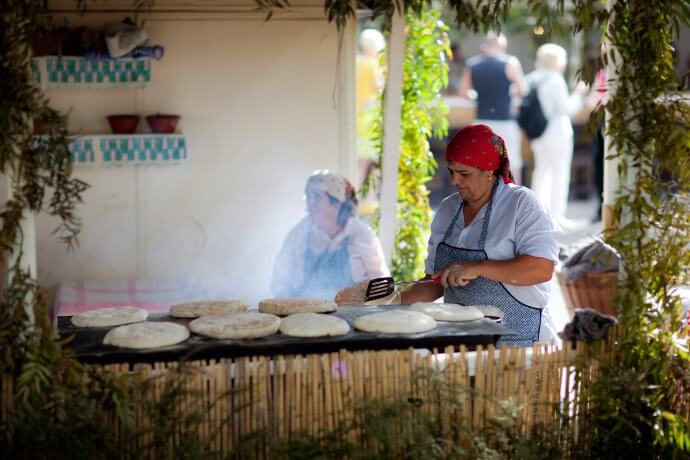
Bolo do Caco, a flat, circular bread that is made from dough, left to rest for several hours before being cooked on a hot stone, is one of the most popular breads on the island and is widely enjoyed by locals and tourists alike. It is a versatile bread that can be served in many different ways, although it is typically served with garlic butter, as an appetizer, or as a sandwich, often with fillings such as tuna or grilled meats, or even cheese or vegetables. It's the ultimate comfort food!
The way it is cooked gives the bread a distinctive texture and flavor that is crispy on the outside and soft and chewy on the inside. But what makes Bolo do Caco truly unique is the use of sweet potato in the dough! This humble root vegetable adds a slightly sweet flavor to the bread and keeps it moist and tender. However, other ingredients used in the dough may include flour, yeast, salt, and sugar.
Bolo do Caco is definitely a must-try for anyone visiting Madeira – you will be impressed by its distinctive flavor and texture! It's hearty and flavorful, and will keep you fueled up for all your island adventures.
Besides being a popular food on the island of Madeira, Bolo do Caco has also gained popularity in other parts of Portugal and beyond. It is often served in Portuguese restaurants and can even be found in some specialty food stores outside of Portugal.
This delicacy is particularly associated with the southern coast of Madeira, especially the area around the town of Câmara de Lobos, a picturesque coastal town known for its natural beauty, with steep hillsides covered in terraced vineyards and colorful buildings lining the waterfront. One of the most iconic landmarks in Câmara de Lobos is the Pico da Torre, a towering rock formation that rises up from the sea. The town is also known for its traditional fishing industry, with brightly painted boats facing the harbor. In fact, one of the most notable landmarks is the Chapel of Nossa Senhora da Conceição, a beautiful 16th-century church that overlooks the port.
Poncha
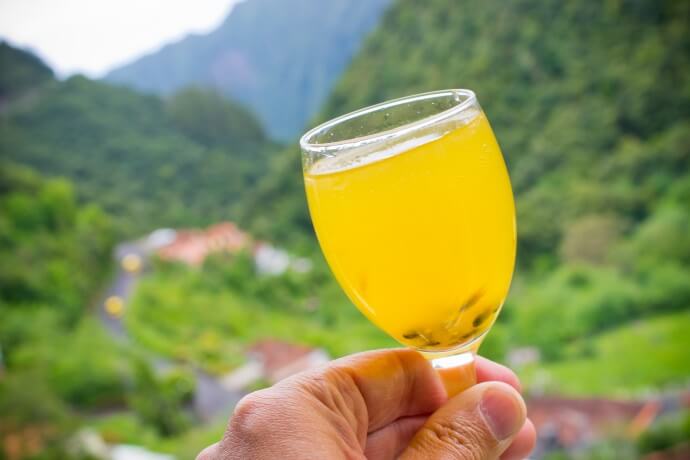
Ah, Poncha! The legendary drink of Madeira that can perk up any evening with its sweet and tangy taste. Poncha is a traditional and popular alcoholic drink that is often served in bars and restaurants throughout the island. It is made by mixing aguardente (a type of distilled alcohol made from sugar cane juice), honey, sugar, and lemon juice, with a wooden stick locally called a "caralhinho". The process of making poncha is almost as fun to watch as it is to drink. It's like a little show in a glass! And the resulting drink is sweet, tangy, and refreshing; but be aware: poncha packs a punch, thanks to the aguardente! The drink is usually served in small cups or glasses, making it the perfect size for sipping and savoring.
The origins of poncha can be traced back to the 19th century when sailors would mix aguardente with honey and lemon to prevent scurvy on long voyages. Over time, the recipe evolved and became a popular drink on the island of Madeira.
Poncha can be enjoyed as an aperitif, a digestif, or simply as a refreshing drink on a hot day. You can customize it to your liking, adding fruit juices, herbs, and spices to make it your own! Want to try a passion fruit poncha? Or how about a tangerine twist? The possibilities are endless.
While poncha can be found throughout Madeira, it is most commonly associated with Câmara de Lobos, where it is often served in traditional taverns and bars. In fact, the town of Câmara de Lobos is known as the "capital of poncha" due to its strong association with the drink.
So go ahead and raise a glass of poncha to the beauty and magic of this island paradise!
Vinho da Madeira
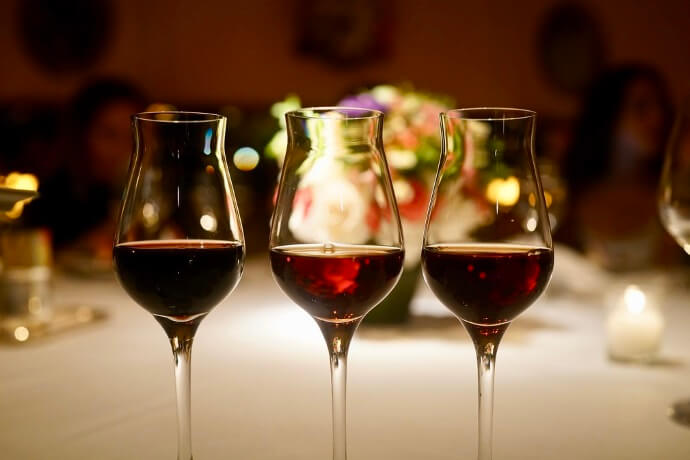
Madeira wine is a fortified and unique wine that has been enjoyed for centuries. It has a rich history that dates back to the 16th century!
This wine is so special that even George Washington had a barrel of it shipped over to celebrate the signing of the US Constitution. And who could blame him? Madeira wine is a delightfully complex and versatile drink that can be enjoyed on its own or paired with a variety of dishes. This wine was once a popular commodity among sailors and traders, due to its long shelf life. In fact, it was often used as ballast on ships sailing from Madeira to the New World. But once the sailors tasted the wine, they quickly realized that it was worth more than its weight in gold. The truth is: a glass of Madeira wine can transport you to another time and place, and leave you feeling like an actual pirate on the high seas!
This wine is made from a variety of grapes, including Tinta Negra, Verdelho, Bual, and Malvasia. The grapes are harvested and then crushed to extract the juice, which is then fermented. Once the fermentation is complete, the wine is fortified by the addition of grape brandy, which stops the fermentation process and increases the alcohol content of the wine. The fortified wine is then aged in oak barrels, where it is subjected to high temperatures and oxidation. This unique process is called "estufagem", and it is what gives Madeira wine its distinctive flavor and aroma!
While Madeira wine is produced throughout the island, the majority of vineyards are located in the regions of São Martinho, known for its beautiful beaches (including Praia Formosa, which is one of the largest beaches on the island) and home to the Lido Promenade, a popular waterfront area with many restaurants, cafes, and shops; Câmara de Lobos; and Porto Santo, a smaller town located on the neighboring island of Porto Santo, which is a part of the Madeira archipelago. The town is known for its long, sandy beaches, which are considered to be some of the best in Europe, and also for its natural beauty, with rugged cliffs, volcanic peaks, and stunning ocean views.
The vineyards of these towns are often planted on steep hillsides, and the grapes are grown in small plots, making the production of Madeira wine a labor-intensive process.
The different styles of Madeira wine, from dry to sweet, make it a versatile option for any occasion. And its long-lasting nature means that you can savor a bottle over the course of several months or even years. You can visit one of the many wineries that produce Madeira wine, and learn about the production process, and taste the different styles of wine. Cheers!
Filete de peixe-espada preto
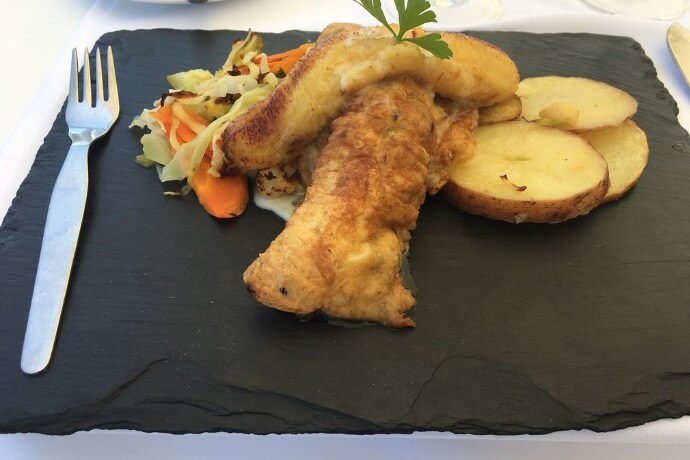
Filete de peixe-espada preto, or black scabbardfish fillet, is a traditional Madeiran dish that is sure to delight any fish lover. The fish is native to the waters around Madeira and is known for its firm white flesh and mild flavor.
First things first, let's talk about the fish itself. The black scabbardfish is a sleek and slimy creature that can grow up to three feet in length. But don't let its appearance fool you: this fish is a true delicacy in Madeira. To prepare the black scabbardfish fillet, the fish is filleted and seasoned with a pinch of salt and pepper, and then lightly coated in flour. Next, the fish is pan-fried in olive oil until it is golden and crispy on the outside, yet still tender and juicy on the inside. This dish is often served with a side of boiled potatoes, fresh salad greens, and the pièce de résistance - fried banana slices! Many restaurants in Madeira serve black scabbardfish fillet with banana slices that have been fried in butter. The sweetness of the banana provides a delicious contrast to the savory fish, and the combination of flavors and textures is truly delightful.
In addition to being delicious, scabbardfish is a lean fish that is high in protein and omega-3 fatty acids, which are important for heart health and brain function.
The fish is found in the deep waters around the island and is particularly associated with the fishing village of Câmara de Lobos, which has a long history as a fishing town. The local fishermen have been catching black scabbardfish for centuries!
Lapas
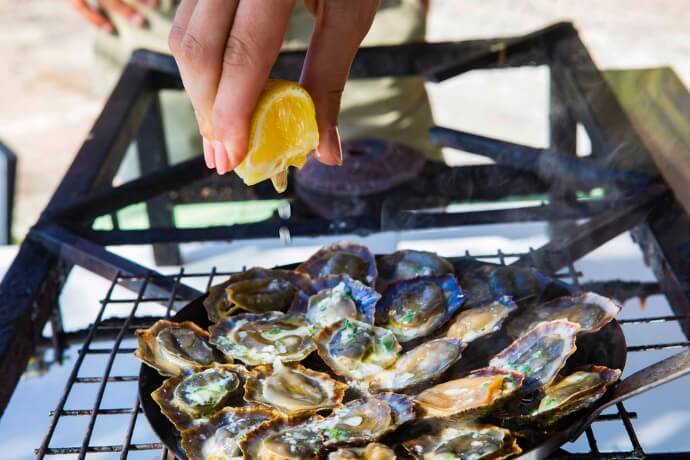
Lapas, the little limpets of Madeira! If you're a seafood lover, you are in for a treat, as they sure pack a tasty punch.
Lapas are essentially limpets - small, cone-shaped sea creatures that live on the rocky shores of Madeira's coastline, and that are harvested by hand during low tide. To prepare the dish, the limpets are cleaned and then simmered in a broth made from garlic, onion, olive oil, and white wine, which imparts a rich flavor to the dish. Some variations of the recipe may also include tomato, bell pepper, or parsley. Lapas are typically served with bread or French fries on the side - and a refreshing glass of Madeira wine is in order as well! It's common to eat lapas as an appetizer, or to share a plate as a snack with friends.
While this dish may seem like an unusual dish to some, it's a beloved part of Madeiran cuisine and a true local delicacy. Lapas can be found all around the coast of Madeira, but they are particularly associated with the region of São Vicente, which is located on the northern coast of the island. São Vicente is a popular destination for seafood lovers, and many local restaurants and cafes offer lapas as a specialty dish. The town is situated in a valley and is surrounded by lush green mountains, making it a popular destination for nature lovers as well.
One of the main attractions is the São Vicente Caves and Volcanism Centre, which offers visitors the opportunity to explore a series of lava tubes and learn about the island's volcanic history. The centre also has a museum that houses a collection of geological specimens and provides information about the island's flora and fauna. Another popular attraction in São Vicente is the Parque Temático da Madeira, a theme park that offers visitors a chance to learn about Madeira's history and culture through interactive exhibits and displays. The park features traditional Madeiran houses, gardens, and an agricultural area where visitors can see crops being grown and harvested.
Despite their small size, lapas are surprisingly nutritious. They're a great source of protein and minerals, so you can indulge guilt-free! If you're feeling adventurous and want to try something new, give lapas a go!
Cracas

The famous cracas are a type of barnacle that is commonly found along the rocky shores of Madeira - and it takes some serious skill and patience to collect these little delicacies. Might be hard for these little guys to win any beauty contests, but they sure are delicious. They're actually a beloved part of Madeiran cuisine and a true local delicacy!
They are first harvested from the rocky shorelines by hand. They're then cleaned thoroughly and boiled in saltwater until they're fully cooked. Some variations of the recipe may also include garlic, onion, and parsley for added flavor. Some people also prefer to grill or sauté them with garlic and herbs. Once cooked, cracas are typically served as a starter or appetizer. To eat them, you'll need to use a small fork or toothpick to extract the tender meat from the shell – but trust us, the effort is worth it. The flavor of cracas is often described as similar to that of crab or lobster - rich, sweet, and slightly briny!
Just like the lapas, it is common to eat cracas as an appetizer, or to share a plate as a snack. These barnacles can be found in various coastal areas around the Madeira Island, as they attach themselves to rocks, piers, and other surfaces in the intertidal zone.
Espetada-madeirense
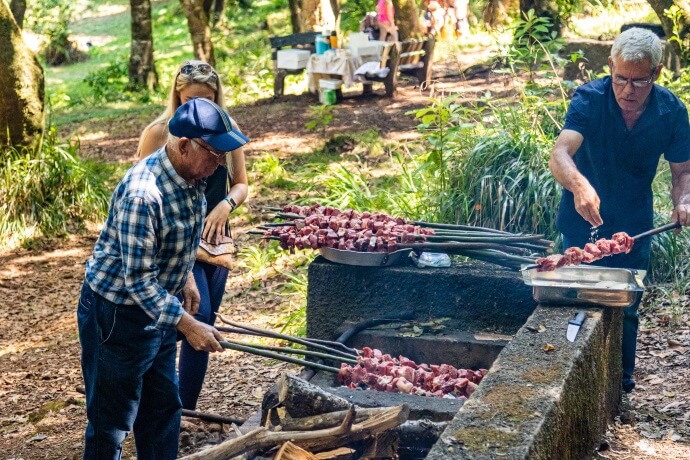
Espetada-madeirense, or Madeiran beef skewers, is a true classic of Madeiran cuisine - a simple yet delicious meal that consists of cubes of marinated beef, grilled on laurel skewers over hot coals and served with a side of fried maize, “milho frito”, and bolo do caco.
The real trick to making espetada-madeirense is getting the marinade just right. The beef is first marinated for several hours in a mixture of garlic, bay leaves, red wine, and spices such as paprika and black pepper. The meat is then threaded onto long skewers, traditionally made of bay leaves, and grilled over hot coals until it's cooked to perfection. The dish is typically served with a side of bolo de caco. The bread is sliced and served warm, with a generous drizzle of garlic and herb butter.
Espetada-madeirense is a hearty and satisfying meal that's perfect for a leisurely dinner with family and friends. The origin of this delicacy dates back to the village and parish of Estreito de Câmara de Lobos – there you will find plenty of restaurants serving this tasty specialty! Originally, this dish was a common meal served at fairs and religious festivities, and it was only served with bread and wine, while the meat was eaten by hand.
If you are a meat lover, then this is the perfect meal for you to try while in the Madeira Island!
Sopa de Trigo
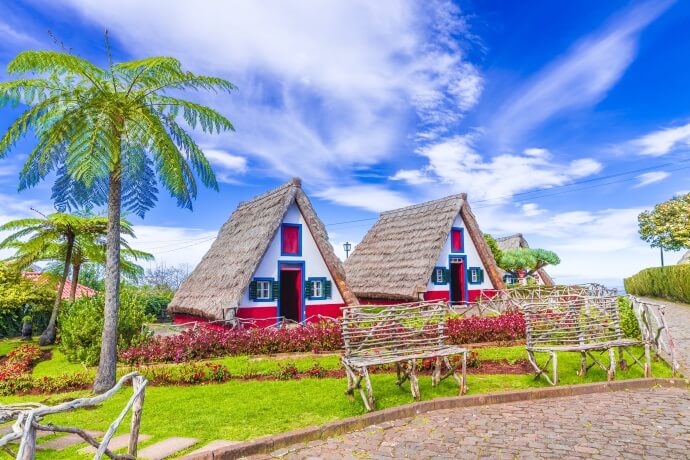
Wheat soup, or sopa de trigo in Portuguese, is a traditional dish that has been a staple in Madeiran cuisine for centuries. It is a simple yet delicious soup made with wheat kernels, which are cooked until tender and then blended to create a creamy base. Vegetables like onions, carrots, and potatoes are added for flavor, and meat such as chicken or beef can also be added to make the soup more substantial. It's the perfect dish to fuel your adventures on the island, whether you're exploring the rugged coastline or hiking through the lush forests.
The key to a great wheat soup is in the seasoning. A variety of herbs and spices such as bay leaves, garlic, and cumin are added to create a complex and satisfying flavor. Some variations of the soup also include the addition of beans or other legumes. It’s like a warm hug in a bowl!
Wheat soup is typically served hot, garnished with fresh herbs like parsley or cilantro. It is often enjoyed as a main course, accompanied by a slice of traditional Madeiran bread. Overall, wheat soup is a comforting and flavorful dish that is a must-try for anyone visiting Madeira. It is very much appreciated by locals and tourists, especially in rural areas and in the parish of Santana, where it is a typical specialty. The beautiful town of Santana is famous for its traditional A-frame houses, known as "palheiros", which have thatched roofs made of straw and are painted in bright colors, typically blue, green, and red. In addition to its charming houses, Santana also offers stunning natural landscapes, including the nearby Madeira Natural Park, which boasts lush forests, scenic hiking trails, and impressive waterfalls.
Picadinho
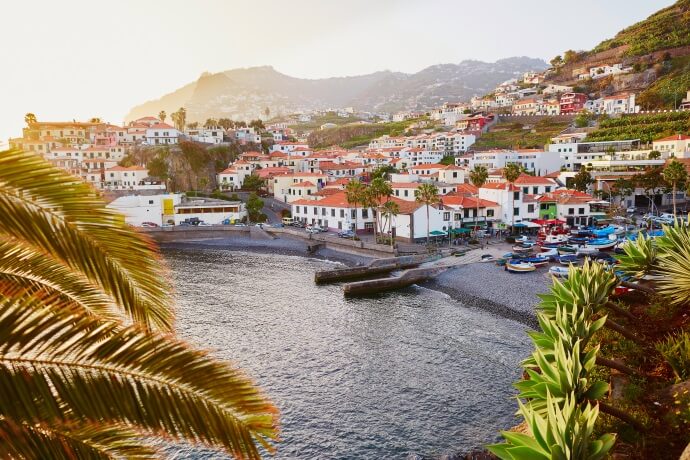
The Picado or Picadinho is a traditional dish from Madeira and it’s the kind of meal that will lift your spirits and fill your belly with joy!
This mouthwatering meal typically includes beef, onions, garlic, tomatoes, and a variety of spices – but what sets picadinho apart from other regular stews is its unique combination of sweet and savory flavors. The addition of Madeira wine, a staple of the island's cuisine, gives the dish a rich and complex flavor that pairs perfectly with the tender chunks of beef.
Picadinho is often served with sides like rice and French fries, making it a satisfying and filling meal. It's the perfect dish to enjoy after a day of exploring Madeira's stunning natural beauty or as a cozy dinner on a chilly evening. While picadinho is a classic Madeiran dish, each restaurant and family may have their own unique take on the recipe. So be sure to try it at multiple places to get a taste of the variety and depth of this traditional stew! The dish is often presented on a platter that is shared among several diners. To eat, you must use a fork or toothpick to pick up small portions of the dish.
This flavorful meal is popular throughout the island and is typical of all regions, rather than specific to any particular one. Be sure to add this dish to your culinary adventure on the island - picadinho is sure to hit the spot!
Cozido Madeirense
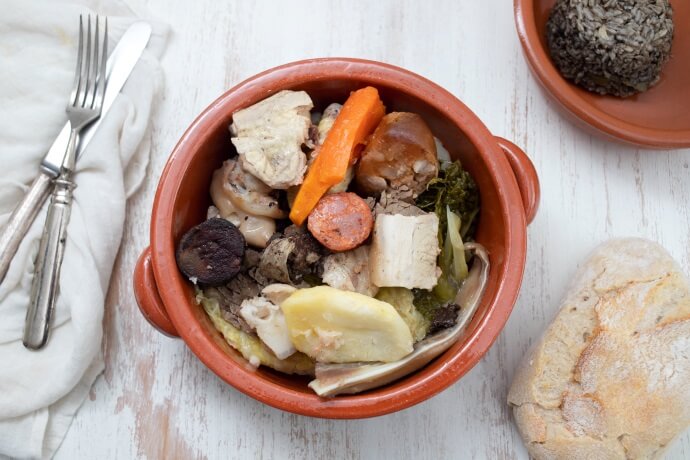
This hearty dish is a perfect representation of Madeiran cuisine, as it combines ingredients that reflect the island's rich cultural history and culinary traditions. The stew typically consists of a variety of meats, such as beef, pork, chicken, and blood sausage, as well as a range of vegetables, including carrots, potatoes, cabbage, and pumpkin. These ingredients are slow-cooked together in a flavorful broth until they are tender and infused with the delicious flavors of the island. This hearty meal is typically served in a big pot, and diners gather around to share the bounty. It's like a communal eating event where everyone can take part in the fun of digging in!
It's also worth noting that Cozido Madeirense is a dish that takes patience and planning to prepare! What makes the Cozido truly special is indeed the way it is traditionally prepared. The stew is typically cooked in an outdoor oven that is heated by hot stones, giving the dish a unique smoky flavor that is difficult to replicate in any other setting. The meats and vegetables are slow-cooked together for hours, allowing all the flavors to meld and create a rich, savory broth. Cozido Madeirense is often served with traditional Madeiran bread, such as bolo do caco, and accompanied by a variety of local condiments, such as piri-piri sauce and Madeira wine.
This popular meal comes from the entire Madeira Island and is enjoyed in various regions. It is a famous and widespread dish that can be found in many restaurants and homes in Madeira. So, if you're a foodie looking for a truly authentic culinary experience, Cozido Madeirense is a must-try dish that will transport you back in time to the olden days of slow cooking and outdoor ovens!
Castanhetas
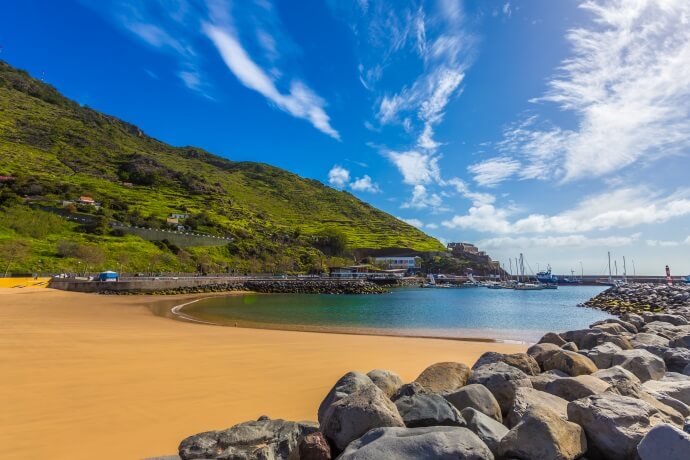
The Castanheta is a type of fish that is commonly found in the waters surrounding Madeira, the Azores, and the Canary Islands. This fish is seasoned with salt and is then fried in hot oil until it is cooked through. Once cooked, the Castanheta can be served with a squeeze of lemon juice and paired with any preferred sides or accompaniments.
It is a truly delicious dish that we highly recommend trying while visiting the charming region of Machico, especially in the village of Caniçal, a small coastal village located on the easternmost point of Madeira Island. The village is known for its picturesque scenery, with rugged cliffs, crystal clear waters, and beautiful sandy beaches. One of the most popular attractions is the Ponta de São Lourenço, which is a stunning nature reserve located at the eastern tip of the island. Machico, on the other hand, is the second most populated municipality on the island, after Funchal. The town is known for its rich history and culture, and was the first place where the Portuguese landed in Madeira in the 15th century. As such, it is home to many historical landmarks, such as the Chapel of Our Lady of Amparo, which dates back to the 15th century, and the Church of Nossa Senhora da Conceição, which was built in the 18th century. One of the most popular attractions in Machico, however, is its gorgeous sandy beach, which is the largest on the island.
Bolo de mel
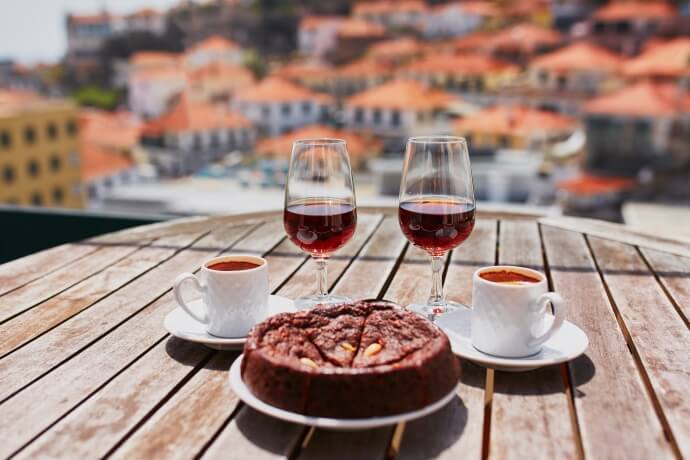
Bolo de mel, or honey cake, is a traditional Madeiran dessert that has been around for centuries. It is a dense, dark cake made with molasses, dark sugar cane honey, flour, spices, and nuts. The recipe varies slightly from family to family, and each baker has their own secret ingredient that sets their cake apart! The cake is usually dense, moist, and has a rich, sweet flavor that pairs well with a cup of coffee or tea.
This sweet delicacy is typically served during the Christmas season, but it can be found in bakeries and cafes throughout the year. In Madeira, it is often served with a glass of Madeira wine or a cup of espresso.
The history of this honey cake dates back to the 15th century, when sugar cane was introduced to Madeira. The cake was originally made with sugar cane syrup, but when sugar became scarce, molasses and honey were used instead. The spices used in the cake, such as cinnamon, nutmeg, and cloves, were added by the Portuguese colonizers who brought them from their colonies in Africa and Asia.
Today, bolo de mel is an important part of Madeiran culture and is often given as a gift or brought to special occasions. Many bakeries and cafes offer their own versions of the cake, so it's worth trying a few to find your favorite!



